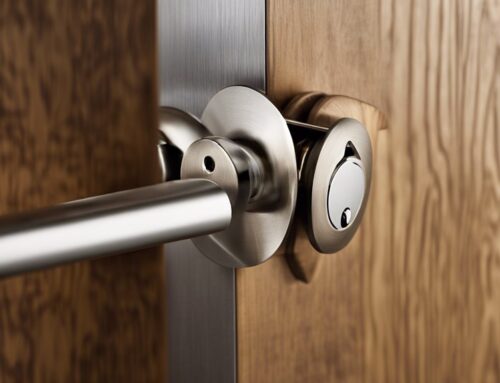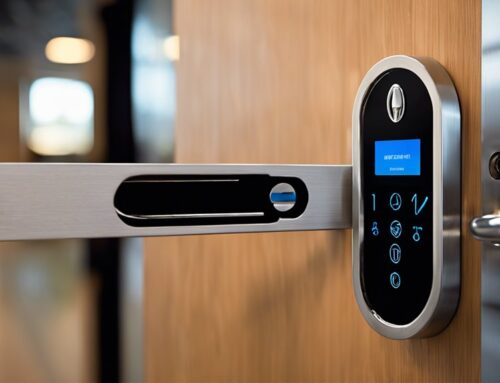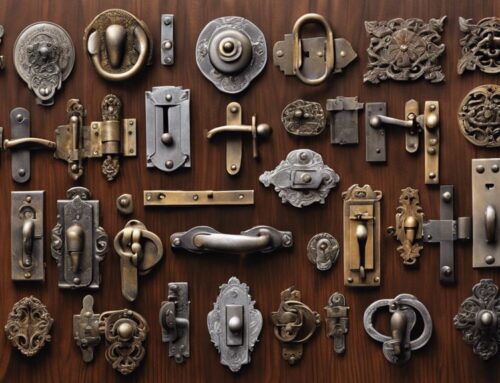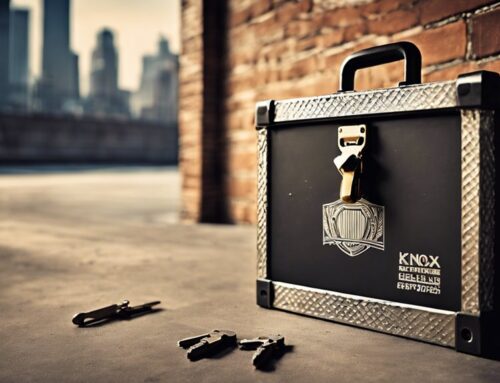Introducing the remarkable Protector Lock, a feat of ingenuity and security that captivated the minds of inventors and locksmiths alike. This exceptional lock, born from the brilliance of Alfred Hobbs and Theodor Kromer, promised an unprecedented level of protection.
With its intricate mechanisms and unyielding design, the Protector Lock stood as a formidable barrier against any unauthorized access.
Join us as we delve into the fascinating history and evolution of this remarkable creation, exploring its roots, innovations, and its enduring legacy in the world of high-security locks.
The Unpickable Chubb Detector Lock
Hobbs showcased his remarkable skill by picking the supposedly unpickable Chubb detector lock at the Crystal Palace Exhibition.
The Chubb detector lock, known for its high security, was believed to be impervious to picking. However, Hobbs proved this assumption wrong with his exceptional talent and knowledge of lock mechanisms.
The Crystal Palace Exhibition provided the perfect platform for Hobbs to demonstrate his expertise in front of an audience seeking a sense of belonging within the locksmithing community.
His success in picking the Chubb detector lock not only established his reputation as a master locksmith but also sparked a new era of innovation in lock design.
This impressive feat challenged the prevailing notion of invincible locks and inspired locksmiths to push the boundaries of security even further.
Invention of the Protector Lock
Alfred Hobbs revolutionized lock technology with his innovative design, the Protector lock. This lock had a significant influence on modern lock design and had a profound impact on the locksmithing industry. Hobbs’s Protector lock was designed to be unpickable, showcasing his ability to pick the supposedly unpickable Chubb detector lock at the Crystal Palace Exhibition. The Protector lock incorporated a transfer in pressure between the lock’s internal bolt and tumbler mechanisms to a fixed pin, making it extremely difficult to manipulate. Despite claiming its superiority, the Protector lock was eventually cracked by one of Chubb’s locksmiths in 1854. However, Hobbs’s lock design paved the way for further advancements in lock technology and set the stage for future innovations in the locksmithing industry.
Table:
| Alfred Hobbs and the Protector Lock | Theodor Kromer and the Kromer Protector Lock |
|---|---|
| – Showcased ability to pick the Chubb detector lock | – Invented the high-security Kromer Protector lock |
| – Invented the Protector lock in the 1850s | – Patented in Prussia in 1874 |
| – Locks were opened using false keys before Hobbs’s design | – Kromer founded the Kromer company in 1868 |
| – Patented the Protector lock with a transfer in pressure mechanism | – Consisted of eleven wafers stacked in a central core |
| – Protector lock was eventually cracked by Chubb’s locksmith | – Keys were difficult to copy with asymmetric, double-bitted keys |
Hobbs’s innovative design and Kromer’s high-security lock revolutionized the locksmithing industry, setting new standards for lock technology and paving the way for future advancements. These advancements have had a lasting impact on the industry, ensuring the security and protection of belongings for individuals and businesses alike.
The High-Security Kromer Protector Lock
Kromer’s high-security lock incorporated unique features such as asymmetric, double-bitted keys and difficult-to-copy bevelled features. It was designed to provide maximum protection against picking and unauthorized access.
Compared to Bramah’s lock, Kromer’s lock boasted several key features that set it apart. Firstly, it utilized asymmetric, double-bitted keys that were extremely difficult to duplicate. This added an extra layer of security, preventing unauthorized individuals from easily obtaining a copy of the key.
Secondly, the lock’s bevelled features made it extremely challenging to manipulate or pick. This intricate design made it nearly impossible for anyone without the correct key to gain access.
Lastly, Kromer’s lock was designed for mass production, which allowed it to quickly outsell Bramah’s lock. This made it more accessible to the general public, further contributing to its popularity.
Overall, Kromer’s lock offered superior security and convenience compared to Bramah’s lock. Its innovative features and mass production capabilities made it one of the most secure locks of its time.
Comparison With Competing Designs
The high-security Kromer Protector lock, designed by Theodor Kromer, outperformed other competing lock designs, such as the Chubb detector lock and Joseph Bramah’s lock, due to its innovative features and superior security.
While the Chubb detector lock showcased its strength by being unpickable, it ultimately fell short when one of Chubb’s locksmiths managed to crack it.
On the other hand, Bramah’s lock, though initially popular, was quickly outsold by Kromer’s lock, which was designed for mass production.
Kromer’s lock boasted eleven wafers stacked in a central cylindrical core, making it extremely difficult to pick. Additionally, the lock’s keys were intentionally designed to be nearly impossible to copy.
The impact of Kromer’s lock on the lock industry was significant, as it set a new standard for security and became one of the most trusted and sought-after locks ever made.
Hobbs’s American Lock
Hobbs’s American lock had the potential for greater security if its internal parts were arranged in a specific way. It offered advantages such as a higher level of security compared to other locks of the time, the potential for customization, and acting as a deterrent to potential burglars. However, it also had its disadvantages. The American lock was known for its complicated design, making it difficult for users to understand and operate. It was also expensive to purchase, making it less accessible to the general public. Additionally, the American lock required a large key, which could be inconvenient to carry and use. Despite its potential for greater security, the complicated and expensive nature of Hobbs’s American lock, along with its large key requirement, presented certain drawbacks that made it less popular compared to other lock designs of the time.
References and Resources
One of the sources, Phillips, mentions Hobbs’s ability to pick the Chubb detector lock at the Crystal Palace Exhibition. This event showcased Hobbs’s exceptional lockpicking skills and highlighted the need for improved security measures.
Over time, techniques for copying difficult to duplicate keys and the evolution of lockpicking tools and methods have played significant roles in the development of high-security locks. Lock manufacturers have continuously strived to create locks that are resistant to picking and key duplication.
From the invention of the Protector lock by Alfred Hobbs to the introduction of the Kromer Protector lock by Theodor Kromer, advancements have been made to ensure the security of valuable possessions. These advancements have led to the creation of complex key designs and sophisticated lockpicking tools, making it increasingly challenging for unauthorized individuals to gain access.
Frequently Asked Questions
How Did Alfred Hobbs Demonstrate His Ability to Pick the Chubb Detector Lock at the Crystal Palace Exhibition?
Alfred Hobbs demonstrated his exceptional lock picking skills at the Crystal Palace Exhibition by successfully picking the Chubb detector lock. Using his expert lock picking techniques, Hobbs showcased his ability to manipulate the lock’s mechanisms and bypass its security features.
His demonstration techniques involved a careful analysis of the lock’s internal components, identifying vulnerabilities, and applying precise movements to unlock it. Through this impressive display of skill, Hobbs proved that even supposedly unpickable locks could be overcome with the right knowledge and technique.
What Was the Key Feature of Hobbs’s Protector Lock That Made It Supposedly Unpickable?
The key feature of Hobbs’s Protector lock that made it supposedly unpickable was a transfer in pressure between the lock’s internal bolt and tumbler mechanisms to a fixed pin.
This innovative design created a complex and intricate system that made it extremely difficult for someone to pick the lock without the correct key.
The Protector lock was hailed as a breakthrough in lock security, providing users with peace of mind and confidence in their valuables’ protection.
Who Eventually Cracked Hobbs’s Protector Lock and When Did It Happen?
Chubb’s locksmith eventually cracked Hobbs’s Protector lock in 1854. The cracking timeline indicates that it took a few years for someone to successfully pick the supposedly unpickable lock. The locksmith likely used various techniques to overcome the lock’s security measures, demonstrating its vulnerability.
This event marked a significant turning point in the perception of the Protector lock’s invincibility and highlighted the importance of continuous innovation in locksmithing.
How Did Theodor Kromer’s Kromer Protector Lock Differ From Joseph Bramah’s Lock?
Theodor Kromer’s Kromer Protector lock differed from Joseph Bramah’s lock in several ways. The evolution of lock picking techniques played a significant role.
Kromer’s lock was designed for mass production and quickly outsold Bramah’s lock. It featured eleven wafers stacked in a central cylindrical core, making it difficult to pick. Additionally, the keys for the Kromer Protector lock were extremely difficult to copy, with asymmetric, double-bitted keys and various bevelled features.
Overall, Kromer’s lock was regarded as one of the most secure locks ever made.
Why Is Kromer’s Lock Considered One of the Most Secure Locks Ever Made?
Kromer’s lock is considered one of the most secure locks ever made due to several factors.
First, it incorporated advancements in lock technology, such as the use of eleven wafers stacked in a central cylindrical core, making it extremely difficult to pick.
Additionally, the keys for the Kromer Protector lock were designed to be highly resistant to copying, with asymmetric, double-bitted keys and various bevelled features.
These features provided significant benefits in terms of security and made Kromer’s lock highly sought after.






